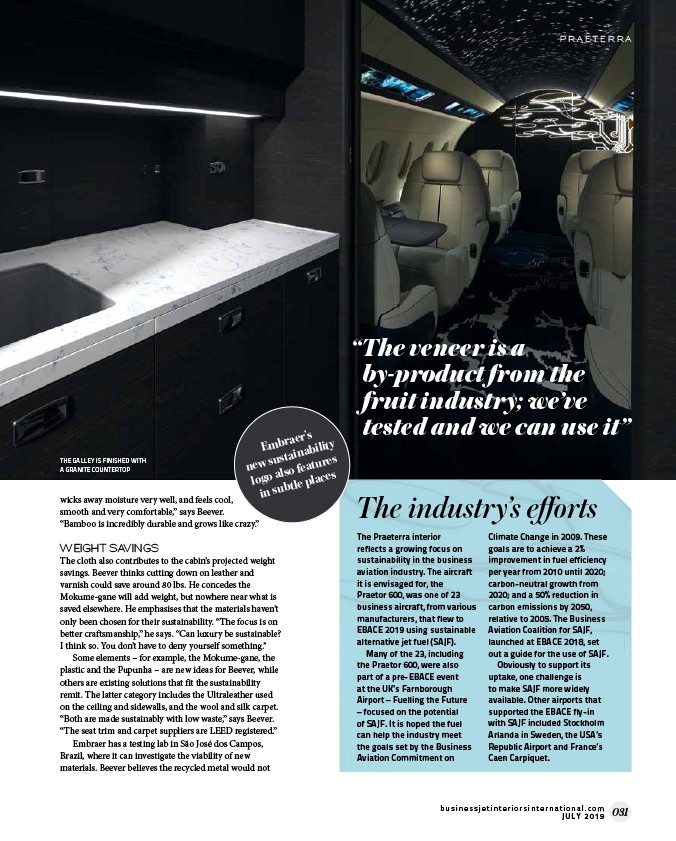
“The veneer is a
by-product from the
fruit industry; we’ve
tested and we can use it”
The industry’s efforts
businessjet inter iorsinternat ional . com 031
JULY 2019
wicks away moisture very well, and feels cool,
smooth and very comfortable,” says Beever.
“Bamboo is incredibly durable and grows like crazy.”
WEIGHT SAVINGS
The cloth also contributes to the cabin’s projected weight
savings. Beever thinks cutting down on leather and
varnish could save around 80 lbs. He concedes the
Mokume-gane will add weight, but nowhere near what is
saved elsewhere. He emphasises that the materials haven’t
only been chosen for their sustainability. “The focus is on
better craftsmanship,” he says. “Can luxury be sustainable?
I think so. You don’t have to deny yourself something.”
Some elements – for example, the Mokume-gane, the
plastic and the Pupunha – are new ideas for Beever, while
others are existing solutions that fit the sustainability
remit. The latter category includes the Ultraleather used
on the ceiling and sidewalls, and the wool and silk carpet.
“Both are made sustainably with low waste,” says Beever.
“The seat trim and carpet suppliers are LEED registered.”
Embraer has a testing lab in São José dos Campos,
Brazil, where it can investigate the viability of new
materials. Beever believes the recycled metal would not
The Praeterra interior
reflects a growing focus on
sustainability in the business
aviation industry. The aircraft
it is envisaged for, the
Praetor 600, was one of 23
business aircraft, from various
manufacturers, that flew to
EBACE 2019 using sustainable
alternative jet fuel (SAJF).
Many of the 23, including
the Praetor 600, were also
part of a pre-EBACE event
at the UK’s Farnborough
Airport – Fuelling the Future
– focused on the potential
of SAJF. It is hoped the fuel
can help the industry meet
the goals set by the Business
Aviation Commitment on
Climate Change in 2009. These
goals are to achieve a 2%
improvement in fuel efficiency
per year from 2010 until 2020;
carbon-neutral growth from
2020; and a 50% reduction in
carbon emissions by 2050,
relative to 2005. The Business
Aviation Coalition for SAJF,
launched at EBACE 2018, set
out a guide for the use of SAJF.
Obviously to support its
uptake, one challenge is
to make SAJF more widely
available. Other airports that
supported the EBACE fly-in
with SAJF included Stockholm
Arlanda in Sweden, the USA’s
Republic Airport and France’s
Caen Carpiquet.
THE GALLEY IS FINISHED WITH
A GRANITE COUNTERTOP Embraer’s
new sustainability
logo also features
in subtle places
PR A ETERRA